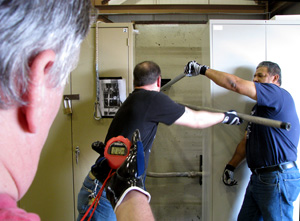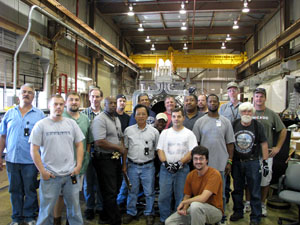Practice makes perfect for NuMI repair crew
 |
| AD mechanical support team members work on a mock up drill to replace a NuMI horn water line. Jim Folkie, senior technician, records the time it takes Keith Anderson, senior technical aid, and Orlando Rivera, contract technician, to tighten a bolt.
|
 |
| AD's NuMI repair crew conducted a mock up drill before replacing a NuMI horn water line.
|
Keith Anderson presses his NFL regulation receiver gloves on tighter. They allow for a good grip, which is crucial, since the slightest slip on a wrench could cost a second, and seconds are precious for Anderson and the rest of the NuMI repair crew.
During the shutdown in October, the NuMI repair crew changed a faulty 60-inch section of suction water line from NuMI's focusing horn 2. The horn focuses pions that later decay into neutrinos. It has become radioactive as a result of beam particle interaction.
Fermilab wants the men near it for as short a time as possible. The repair team's goal is to follow the laboratory practice of ALARA in keep individual exposure levels as low as reasonable achievable. They take pride in cutting seconds off the total repair time, to reduce personnel radiation exposure levels, without sacrificing safety. The crew was able to keep their exposure at 25 percent of their laboratory's exposure goal for this task.
The secret is practice and team work. When the 50,000 pound beamline positioning module and its associated focusing horn are removed from the beamline, it must hover partially inside the work cell during the repair process. But the men can't risk radiation exposure or damaging the horn by practicing in the target hall cavern, so they built a mock work cell above ground prior to the repair.
During the mock repair in October, the 16 team members honed removal of a leaking suction pipe into a choreographed dance with hand tools, work boots and stop watches.
"No one has done this type of confined fix before," said Tony Busch, a RAD technician in AD. "The first time through will be two or three times longer than the actual repair. People need to learn where to stand and the technique for handling a 30-pound, four foot long wrench."
Towering metal filing cabinets mimic the concrete block walls that will be used for shielding. Each man has at most 20 seconds to do his part -- one twist of a bolt, one yank of a handle - and then roll quickly out of the way so the next man can perform his task.
"We won't know exactly what we are in for until we get down there. That is why we build a mock up to practice," said Kris Anderson, group leader NuMI target hall operations in the Mechanical Support Department.
The most focused tense up for the burst of action and get the movement down to 8.5 or 8 seconds. Keith Anderson jumped back from the opening and pressed his back against the mock shielding wall, having done what was to be the final turn with the wrench.
He shook his head in disappointment.
"Not even close," he said. "It still needs two turns. If it's not tight, it will leak."
They start again.
During the real horn repair the next day, the crew found that corrosion on the old line fitting, made it more difficult to unhook than expected. No problem. Thanks to practicing potential setbacks, the crew replaced the horn in well under the five minute allocated exposure time.
"This is basically like a NASCAR pit stop. We want to do things fast, but we don't want to do it wildly," said Kris Anderson. "We want to do it right."
-- Tona Kunz
|